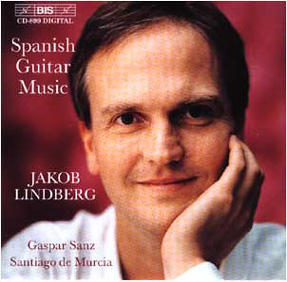
Baroque guitar music from Spain and the Spanish Empire is sometimes
performed these days in highly 'orchestrated' arrangements, featuring
multiple guitars, harps, percussion, bowed instruments and even dancers. ….
Jakob Lindberg, that aristocrat of the lute and early guitar, makes
such additions seem a little vulgar. By playing these pieces 'straight'
though with due fire and flamboyance when warranted, he emphasizes
their more refined qualities.
International Record Review
Jakob Lindberg bereitet auf der Barockgitarre Teile von Sanz' 1674/1675
erschienener Instrucción de musica sobre la guitarra española so lebendig,
klangschön und sprechend auf, dass sich der Reiz dieser von volkstümlichen
Weisen und Rhythmen geprägten Musik unmittelbar mitteilt. Ähnliches gilt
auch für Santiago de Murcias etwa 50 Jahre jüngeren Codex Salvidor (Nr 4),
der unter anderem eines der frühesten Beispiele für den damals erst in
Mode gekommenen Fandango enthält. Lindberg nähert sich ihm wie auch den
hier grössenteils vertretenen älteren Tanzformen mit grossem Elan und
einem (selbst bei horrend schnellen Passagen) bewundernswerten Präzision.
Klassik Heute
During the 17th century the five-course baroque guitar was known throughout Europe as the 'Spanish Guitar'. This recording is dedicated to two of the greatest exponents of Spanish baroque music, Gaspar Sanz and Santiago de Murcia. Through their music we have marvellous examples of a Spanish musical tradition that flourished despite strong influences from abroad. A crucial aspect when performing music on the baroque guitar is to decide which way to tune the instrument. Here two tunings are used, one without the lower octaves on the fourth and fifth courses for Sanz and one with these 'bordones' for the music by Santiago de Murcia. The third course is tuned in unison, unlike 'modern' trends to add a higher octave.
